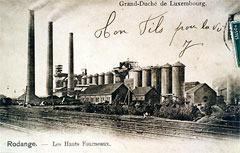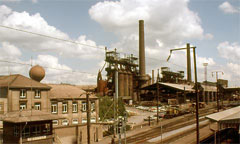|

 Established in 1872 under the
name of S.A. des Hauts Fourneaux
de Rodange, the enterprise
limited its activity to the
production of pig iron until
1907 when a Thomas steel melting
shop was installed, along with
several rolling mills. Meanwhile,
in 1905, the company had merged
with S.A. Ougrée-Marihaye, a
Belgian iron and steel producer
of which the plant at Rodange
became a division.
Established in 1872 under the
name of S.A. des Hauts Fourneaux
de Rodange, the enterprise
limited its activity to the
production of pig iron until
1907 when a Thomas steel melting
shop was installed, along with
several rolling mills. Meanwhile,
in 1905, the company had merged
with S.A. Ougrée-Marihaye, a
Belgian iron and steel producer
of which the plant at Rodange
became a division.
 In 1935, the works again
became autonomous with its
incorporation as a distinct
limited company under the
denomination of S.A. Minière et
Métallurgique de Rodange.
In 1935, the works again
became autonomous with its
incorporation as a distinct
limited company under the
denomination of S.A. Minière et
Métallurgique de Rodange.
The installed section mill was
completed by a 600 mm mill train
for special sections and a 300
mm bar mill train to which was
added a wire rolling train
in 1950,.
 During the 1950's, the Thomas
melting shop was adapted to
bottom-blowing with enriched
air. An LDAC converter was
installed in 1964. In 1971 the
Thomas converters were adapted
to blowing with pure oxygen by
the OBM process.
During the 1950's, the Thomas
melting shop was adapted to
bottom-blowing with enriched
air. An LDAC converter was
installed in 1964. In 1971 the
Thomas converters were adapted
to blowing with pure oxygen by
the OBM process.
The bar and wire mill was
completely modernized in 1969,
and in 1970 a new blooming mill
came into operation.
 In 1973 the company merged
with the Athus division of
Cockerill (Belgium) to form S.A.
Métallurgique et Minière de
Rodange-Athus.
In 1973 the company merged
with the Athus division of
Cockerill (Belgium) to form S.A.
Métallurgique et Minière de
Rodange-Athus.
 Industrial restructuring,
enforced by the steel industry
crisis which began in 1974, led
to the complete shut- down of
the Athus division, located in
Belgium, and the cessation of
hot metal production at the
Rodange works in the Grand Duchy
of Luxembourg.
Industrial restructuring,
enforced by the steel industry
crisis which began in 1974, led
to the complete shut- down of
the Athus division, located in
Belgium, and the cessation of
hot metal production at the
Rodange works in the Grand Duchy
of Luxembourg.
 An agreement reached in 1977
with the Belgian and Luxembourg
governments, as well as with
ARBED, enabled the company to
make a fresh start as a
reroller, and thus to undertake,
on an improved basis, the
investments needed to guarantee
high technical levels and
improved productivity.
An agreement reached in 1977
with the Belgian and Luxembourg
governments, as well as with
ARBED, enabled the company to
make a fresh start as a
reroller, and thus to undertake,
on an improved basis, the
investments needed to guarantee
high technical levels and
improved productivity.
 The section mill was
modernized in stages:
installation of a walking- beam
reheating furnace, modernization
of the layout of the mill train
and of the rail finishing shop.
The section mill was
modernized in stages:
installation of a walking- beam
reheating furnace, modernization
of the layout of the mill train
and of the rail finishing shop.
A pilot installation for heat
treatment of rails put into
operation at the end of 1985
enables Rodange to maintain its
position in the leading group of
manufacturers of rails, a
product which has always been
the speciality of the company.
 In 1994 the steel plant of Esch–Schifflange,
with its freshly installed electric furnace
and the rolling mills of Rodange, merged
into one company, ARES.
In 1994 the steel plant of Esch–Schifflange,
with its freshly installed electric furnace
and the rolling mills of Rodange, merged
into one company, ARES.
|
|
|
|
|
|
1994 |
Creation of ARES
(76% owned by ArcelorMittal Profil Luxembourg
S.A.) |
|
2002 |
Creation of
ARCELOR
(merger of ARBED (Luxembourg),
ACERALIA (Spain) and USINOR (France) |
|
2005 |
Revamping of Mill
“C" |
|
2006 |
ARES renamed
Arcelor Rodange S.A. |
|
2007 |
Creation of ArcelorMittal |
|
2007 |
Revamping of Mill
“A" |
|
2008 |
Arcelor Rodange
S.A. renamed in ArcelorMittal Rodange and
Schifflange S.A. |
|
|
|
|
|
|
1872 |
Foundation of
“S.A. desHauts Fourneaux de Rodange |
|
1969 |
Revamping of Mill
“C" |
|
1973 |
Foundation of
MMRA |
|
1978 |
Shut down of
Mines, Foundry,Blast Furnaces and Steelplant |
|
1978 |
Participation of ARBED |
|
|
|
1871 |
Foundation of
"Metzeschmelz" |
|
1911 |
Creation of
“ARBED |
|
1981 |
Start-up of
billet caster |
|
1994 |
Start-up of electrical arc
furnace |
external
Links :
http://www.rail.lu/mmrusine.html
http://www.industrie.lu |